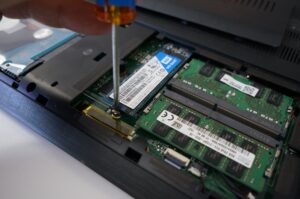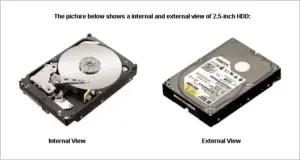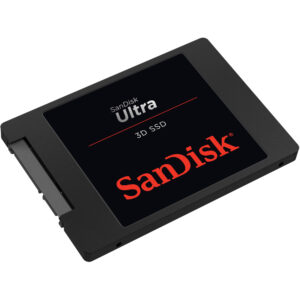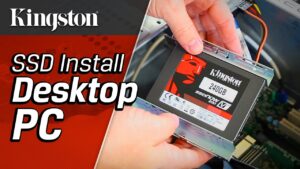How to Convert Internal Ssd to External? Full Guide!
To convert an internal SSD to external, you will need a USB 3.0 hard drive enclosure and an appropriate power adapter for the enclosure.
First, connect the SSD to the SATA connector inside of the hard drive enclosure with screws provided by the manufacturer of your HDD Enclosure.
Connect the internal SSD to a USB external enclosure via an available SATA port. Attach the power and data cables to the drive, then secure it with screws.
Place the cover back on and screw into place, if needed. Plug in your newly converted external SSD device into any computer’s USB port for use.
Here is a table:
| Step | Instruction |
|---|---|
| 1 | Purchase an external SSD enclosure that matches the size and interface of your internal SSD. |
| 2 | Power down your computer and unplug it from the wall. |
| 3 | Open your computer case and locate the internal SSD. |
| 4 | Disconnect the internal SSD from the computer by unplugging the cables or removing any screws holding it in place. |
| 5 | Carefully insert the internal SSD into the external SSD enclosure, making sure it is securely in place. |
| 6 | Connect the cables provided with the external SSD enclosure to the appropriate ports on the enclosure and your computer. |
| 7 | Plug in the external SSD enclosure to a power source and turn on your computer. |
| 8 | If your computer does not automatically recognize the external SSD, go to “Disk Management” in Windows or “Disk Utility” in macOS to format the drive and assign a drive letter. |
| 9 | Once the external SSD is recognized and formatted, you can transfer files to and from it just like any other external storage device. |
| 10 | When you’re finished using the external SSD, safely eject it from your computer and power it down before unplugging any cables or removing the SSD from the enclosure. |
Can You Convert an Internal Ssd to an External Ssd?
Yes, it is possible to convert an internal SSD into an external one. To do so, you will need a SATA-to-USB adapter or enclosure that supports the drive’s form factor and interface.
Once connected to your computer via USB, your system should recognize the drive as an external storage device and allow you to use it just like any other external hard drive or SSD.
Additionally, some manufacturers offer specialized enclosures for converting internal drives into externally accessible ones. Converting an internal SSD to external can be done quickly and easily with minimal effort and cost.
Can You Make an Internal Ssd Drive External?
Yes, it is possible to make an internal SSD drive external. You will need a USB 3.0 or Thunderbolt enclosure for this purpose.
This type of enclosure allows you to connect the SSD internally via SATA and then use the USB or Thunderbolt ports on the outside of the case to transfer data from your device to the drive and vice versa.
The process is relatively straightforward; all you have to do is mount your SSD into the enclosure, screw in any necessary screws that may come with it, plug in one end of a cable into your laptop/computer’s USB port and plug in another end into an empty slot inside your new enclosure, then turn on power switch located at back of hard drive casing before connecting it with your device’s USB port again.
Once connected properly you should be able to read files off or write them onto the disk just like any other external storage device.
Can You Plug an Ssd into a Usb Port?
Yes, you can plug an SSD into a USB port. This is possible through the use of adaptors such as M.2 to USB or SATA to USB adaptors.
These allow the SSD to connect via its internal interface (usually either SATA or PCIe) and then be connected externally through a single USB cable.
Doing this also allows for fast data transfer speeds as modern external storage devices are capable of reaching read/write speeds of up to 400 MB/s on most occasions when plugged into a high-speed 3.0 compatible connection port.
Can I Replace My Internal Hdd With an External Ssd?
Yes, you can replace your internal HDD with an external SSD. While the process is slightly more complicated than simply swapping out a traditional hard drive for another one, it is still relatively simple and straightforward.
First, you’ll need to purchase an enclosure that will house the SSD — these come in various sizes and connections (e.g., USB-C or Thunderbolt).
After you’ve got the enclosure set up, all you have to do is insert the SSD into it and connect it via USB or Thunderbolt port on your computer.
Once connected, most computers will recognize it as a new storage device and allow you to format/partition it accordingly so that files can be written/read from either the internal HDD or external SSD depending on which option works best for your individual needs.
How to Use M2 Ssd As External Storage
Using an M2 SSD as external storage is a great way to increase the storage capacity of your computer or laptop. It’s easy to do, and you don’t even need any extra hardware.
All you’ll need is an M2 SSD in the form factor that is compatible with your device, an enclosure for it, and a USB cable that can support data transfer speeds up to 10 Gbps (USB 3.1).
Once everything is connected, simply format the drive using your operating system’s built-in disk management utility and start transferring files!
How to Connect Ssd to Laptop Externally
Connecting an SSD to your laptop externally is a great way to increase the storage capacity of your device without needing to replace its internal hard drive.
To do so, you’ll need either a USB 3.0 or Thunderbolt 3 connection and an appropriate cable for connecting the two devices.
Once connected, you can transfer files from one device to another or use the external drive as additional storage space for your laptop’s operating system and applications.
How to Use Ssd As Usb Drive
Using an SSD as a USB drive is a great way to increase portability and expand the storage capacity of your device. To use an SSD as a USB drive, you’ll need an external hard drive enclosure that supports the type of SSD you have.
Once the enclosure is connected to your computer, simply mount the SSD in it and plug it into any available USB port on your machine.
Your computer should now recognize the new storage device and allow you to access its contents like any other external drive.
Frequently Asked Question
What Materials Do I Need to Convert an Internal Ssd to External?
To convert an internal SSD to external, you will need a USB-to-SATA adapter and a USB 3.0 cable. Additionally, an enclosure may be required depending on the size of your drive.
How Can I Make Sure That the Conversion is Done Safely And Securely?
To ensure the conversion is done safely and securely, you should use a reliable file converter that encrypts your data with secure protocols. Additionally, make sure to back up the original files and store them in a safe place before conversion.
Is It Possible to Use an Existing External Enclosure for This Process, Or Must a New One Be Purchased?
Yes, it is possible to use an existing external enclosure for this process if it meets the requirements.
Can This Process Be Done by Someone With Limited Technical Knowledge of Computers?
Yes, this process can be done by someone with limited technical knowledge of computers as long as they have basic skills such as navigating a computer and using applications.
Conclusion
In conclusion, converting an internal SSD to external can be a great way to take advantage of the speed and performance benefits of solid state drives. With the right tools and instructions it is not difficult to do so.
Converting an internal drive into an external one can give you the flexibility needed for data transfer between multiple devices or even accessing your data remotely from anywhere in the world.
In addition, with proper formatting, you will have no problem taking advantage of advanced features such as encryption for added security or extra storage capacity.





